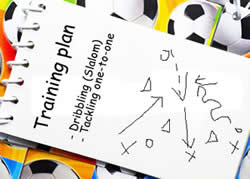Doomed to failure?
We often get the question why aren‘t there training plans available at Soccerpilot ? The answer is quite simple:
Each team is different. One can‘t just put together workouts and place them under your noses, that would be going the wrong way. As a coach it is important to observe the team and identify its weaknesses. This includes not only the shortcomings of the entire team, the individual residues in the training should also be carefully analyzed. Here it doesn’t matter whether the weaknesses are of tactical, creative or technical nature. The only person that can judge the training level of a team is the one who is responsible for it, namely the coach.
Problems with the training plan
Does a training plan make sense at all?
Of course! There are educational goals for all age ranges, towards which one should work. But stubbornly adhere to guidelines for each age range, or even select soccer drills because they claim to be suitable for a certain age range, may be completely wrong.
"Goal for a certain age range not achieved" ... and now?
Let us exagerate, so the problem will be clearer. Let's say a player discoveres his passion for soccer only at the age of 12 years, and comes to you in the team.
One of the goals for this age group is the learning of different group tactics. For example, the defense should be in groups of three according to the training content. What do we do with the children who have missed the first training year, or still have significant deficiencies at a technical level? Do we send these children away, or say: "The class did not reach the target, it will be better to go in the U10 or U8?"

No reasonable soccer coach would do this, unless it comes to performance-oriented soccer. A downgrading to younger age groups is certainly the wrong way to go, at least in the game activity. This could be possible in training, but it isn’t planned anywhere.
Performance gaps in the team and the training plan
Every coach knows this: the team’s performance gap ruins the sequence of soccer drills and thus directly affects the training plan. It often leads to over- or underuse of individual players or groups of players within the team.
An ideal of a consistent training over the years is only to be found rarely. Although it is described in many approaches, it isn’t actually available. There will always be performance differences between players of the same age. This is logical and should not be ignored here. Often these differences are homemade, because the players are at different stages of development and training.
Worst case scenario it comes to a drop-out, the players turn their backs to soccer, or even worse, to sport at all. If the social structure of the team is failing and fun is increasingly missing, whether it be through over- or under-challenging the team, the players will not be easily kept.
The right training plan
Happy the coach who finds a consistent training approach in his club.
This way it will be possible to transfer the children from training level to training level with a new coach, or consistenly be trained by the same coach. However this isn’t really of great help, because in most cases the coach is a lone fighter and not integrated into a single concept. In further articles we will deal with the preparation of training plans and provide the appropriate templates.
This much is for sure: as a coach one should think about which areas (individual tactics, group tactics, team tactics, goal/kick, dribbling, tackling drills, etc.) should be trained, taking into account the capacity and age of the players.
Try to organize your team in various training categories and to offer different levels of difficulty, or even entirely different contents for each group. Two or three groups would be enough here as this is usually an amount that one coach can control and correct without the help of an assistant. One or even two co-coaches would of course be helpful. When time allows it, players can alternately receive a 15-minute "special training", known for example for goalkeeper trainings.
Of course all this means work and not only a simple „Let‘s do some training now!” Just plan your training now for the next four weeks and try it. If you're in a fortunate position where you have one or two co-trainers trust them and get them involved in the planning. Discuss with them your plans and ideas for the next few weeks, what are your goals and what soccer drills you want to offer.